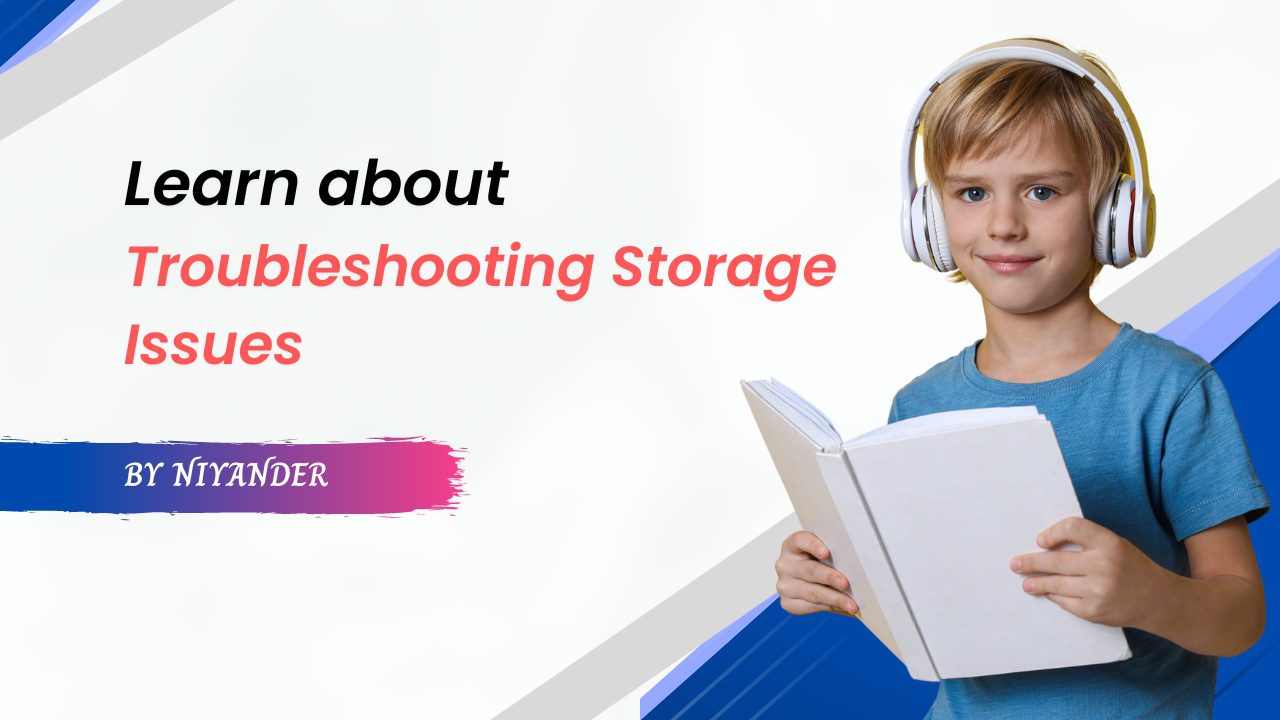Troubleshooting Storage Issues
Welcome to “Troubleshooting Storage Issues.” After reading this article, you will be able to:
Also visit: Local Storage with Multiple Drives
- Describe common causes of storage failures.
- Explain the troubleshooting steps for various storage types.
- Investigate and resolve slow performance.
Troubleshooting Storage Issues
Hard drive failure
Disk failure or hard drive failure can be caused by wear and tear over time, faulty manufacturing, or power loss (especially when the disk is reading or writing). Here are some symptoms of disk failure.
- Read/write failure, you get an error message when you open or save a file.
- Blue Screen of Death (or BSoD) is a system STOP error caused by a severe read/write failure.
- A Bad sectors error means that part of a disk is unreliable and needs to be fixed.
- Constant LED activity (or disk thrashing) may indicate insufficient RAM, with data moving back and forth between RAM and the hard disk.
- A clicking or grinding noise is a sign of a problem. When you see these symptoms, replace the disk to avoid data loss.
chkdsk tool and the SMART
The chkdsk tool and the SMART program are used to monitor and troubleshoot disk health. SMART or Self-Monitoring, Analysis, and Reporting Technology can be set to send an alert when a disk is unreliable.
- Check disk tools find bad sectors and fix system errors.
- A check disk run test (chkdsk /r) locates bad sectors each time it is run.
- You can use check disk fix (chkdsk /f) to fix file system errors, but it won’t find bad sectors.
Additional diagnostic programs are available from software and hardware vendors or may come prepackaged with certain systems.
Boot Failures
When a computer fails to boot, the first step is to check for lights and sounds associated with power up. If these don’t come on, check to see if the device is plugged in. If the device powers up but still does not boot, check the drive configuration to ensure that: Firmware system setup has the correct boot sequence, and no removable disks are present. Data cables are connected to the drive correctly and free from damage. Motherboard port is not disabled by system setup. If the drive configuration is fine, it may be a filesystem error. Use the Windows setup disc to boot into the recovery environment and enter “C:” in the command prompt.
- If it says, “Invalid media type”, try the bootrec tool, or reformat the disk (erases all data).
- If it says, “invalid drive specification”, check the partition structure with diskpart.
Boot Block Repaire
Errors like “Invalid drive specification” or “OSS not found” indicate boot errors. Boot errors are caused by disk corruption, incorrect OS installation, or viruses. To resolve: Try your antivirus software’s boot disk option to detect potential viruses. Then use the antivirus software’s recovery disk option, if available. If the problem persists, boot with the original product disk and choose Repair.
- Try Startup Repair first, or use the command prompt to: Try fixing MBR.
- Try fixing boot sector, or to try correcting missing installations in the Boot Configuration Database then restart.
For computers that won’t boot,
You can try to recover files by removing the hard drive and connecting it to another computer. External enclosure kits let you secure the removed drive and connect it to other computers using a USB cable. If possible, Inspect and recover the drive’s files via Windows Disk Management. Or use chdsk to restore fragments of corrupted files, but keep in mind that third-party file recovery software may work better.
Disk performance issues
Disk performance can slow If a disk is older, too full, or its files are not optimized for fast access.
To improve performance:
- Defragment the drive for faster file access.
- Add RAM. Upgrade to a solid state drive or hybrid drive.
- Remove files and applications, or add additional drive space.
Optical drives
Optical drives are laser-based and don’t physically touch disks. Here are some useful optical drive tips: Cleaning kits can often resolve common read/write errors. CD-ROM drives cannot read DVD-ROM disks. Third-party software is available for DVD and Blu-Ray disk support. Writable disks have recommended write speeds that affect quality and vary depending on the brand. When the OS is too slow for the optical drive’s write process (buffer underrun), errors occur.
To fix this issue:
- Use the latest CD and DVD writers.
- Burn at a lower write speed.
- Close all other applications when burning,
- or copy data to the hard drive instead of to disk.
Troubleshooting RAID
Here are some common RAID troubleshooting steps: If a RAID array is not detected at setup or boot, ensure RAID controller drivers are installed and verify status. If the configuration tool is unavailable, the controller may have failed. If a RAID disk fails, you will get an alert.
- If the RAID array supports redundant drives and hot swapping, just insert a new drive, and then rebuild array with the configuration tool.
- Performance is impacted during the RAID array rebuilding process as it commonly involves large data transfers. Take care to only remove the failed disk.
- Removing a healthy disk can also cause a RAID array to fail. If too many disks fail, use backup and recovery solutions.
- A non-redundant RAID failure (like RAID 0) means both disk and data are lost. If the controller fails, install a new controller or import the disks into another system.
Summary
In this video, you learned that: Disk failure is caused by faulty manufacturing, wear and tear over time, or power loss. Disk integrity is checked with chkdsk and SMART. In boot failure, first, check for power up (lights and sounds), then drive configuration. Space, RAM, or new drives improves performance. Fast write speeds cause optical drive errors. Rebuilding a RAID array slows performance. Removing a healthy disk can cause RAID failure.

